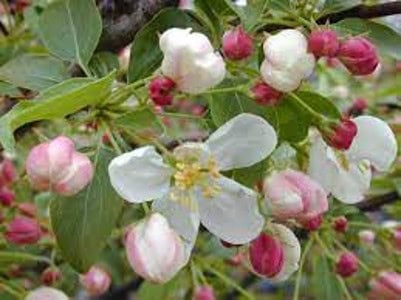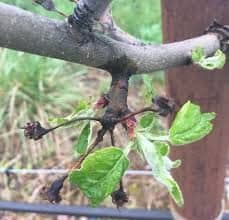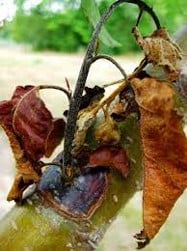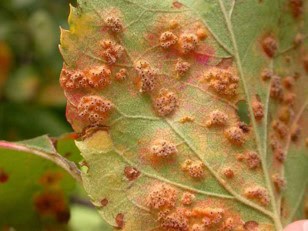Malus (apples & crabapples) – is a genus with a wide variety of species, varieties, and cultivars. Plants in this genus are generally very susceptible to a wide variety of pests and diseases including but not limited to: fire blight, scab, cedar-apple rust, aphids, etc.

Check for Fireblight
Cankers produce a white or amber ooze which contains the bacteria. Symptoms begin as dark green, water-soaked spots on tissue where it is penetrated by bacteria. Common entry points are through wounds & blossoms.
As the disease progresses, leaves and twigs take on a black shriveled appearance as if scorched by fire. A characteristic shepherd’s crook often develops as tender growth rapidly wilts and dies. As the twigs die back, dead sunken areas on the stem called cankers develop. These can girdle the stem causing even more dieback.
Young trees can be killed in one season. Affected trees can be sprayed now to prevent the spread.
Prune out affected branches if possible but be sure to disinfect pruning tools after EVERY CUT – otherwise it’ll spread easily to clean tissue.



Check for Cedar-Apple Rust
Cedar-Apple Rust migrates between two hosts. The real damage is done to plants in the Malus group.
2″ Grey-brown galls will appear on Junipers but don’t typically harm the tree.
Removing them before they release the yellow-orange gelatinous spores will slow the spread to Malus.
Primarily a disease of apples and crabapples – but can also affect pears, quince, serviceberry, cotoneaster, and chokeberry.
Circular, yellow spots (lesions) appear on the upper surfaces of the leaves shortly after bloom. In late summer, brownish clusters appear beneath the yellow leaf spots or on fruits and twigs.


Check for Aphids
Aphids are one of the most common insect problems and in sufficient numbers can cause the new growth to become curled and twisted.
Damage occurs when the aphid sucks the juices from leaves.
High pressure water spray can knock off a large percentage of the aphids.
Use horticultural oil for moderate infestations.
Heavy populations can be sprayed with chemical insecticides but should be a last resort because it will also kill beneficial insects that naturally feed on the aphids.
